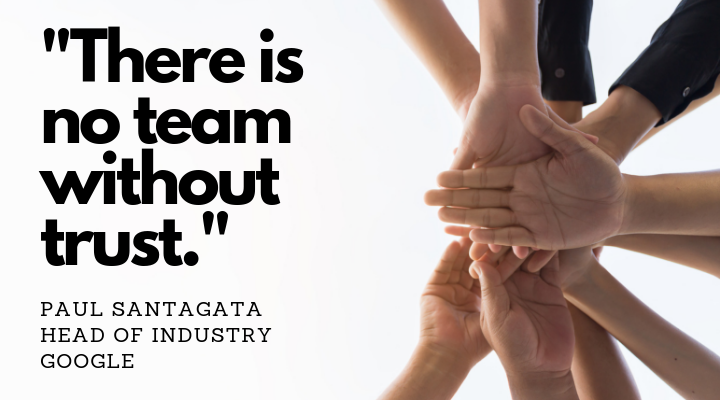Think about the last group you were part of where trust was high. It could be a work team, your family unit, or maybe a community group. Jot down or make a mental note of how that influenced you and your performance.
Now recall the last group you were part of where trust didn’t exist. What was the result of that situation? How did it impact your performance, the groups results, and the connection within the team?

Google’s massive two-year study of team performance found that high-performing teams have one thing in common: psychological safety.
It makes sense, right? Safety is the bedrock of success. It drives creativity, innovation, and collaboration. A lack of safety creates a vicious cycle of defensiveness, short-term thinking, and groupthink.
Regardless of the size or makeup of your team, how can you cultivate an environment of psychological safety?
Tips to Create Psychological Safety
Here are three of our favorite tips from Harvard Business Review article, High Performing Teams Need Psychological Safety. Here’s How to Create It.
Navigate conflict with collaboration
In the face of conflict, are you a collaborator or are you an opponent? Typically, when people feel attacked, they defend. When people feel pushed, they push back.
The surest way to destroy psychological safety is to get into a ME vs. YOU dynamic.
So how can you move from being an opponent to being a collaborator? Proceed together!
Stop: How are you going to make this better?
Start: How can we move forward together
Replace blame and judgment with curiosity.
It’s irresistible to be right. It gives the brain a sense of certainty that it craves, and it literally releases dopamine in response. So when things go wrong, it’s not uncommon to immediately go to blame.
But blame in a team setting can escalate conflict and lead to defensiveness.
Curiosity, on the other hand, drives empathy, connection and the psychological safety that underlies successful teams. To shift more toward curiosity, try replacing statements with questions.
Stop: He is not doing a good job because he’s lazy.
Start: I am not satisfied with how things are going. I wonder how he’s feeling and what’s going on for him?
Measure psychological safety, anecdotally or analytically.
It’s a Catch-22. When employees are experiencing low levels of psychological safety, they probably won’t feel comfortable speaking up about it.
As a leader, you need to take on the responsibility to be vulnerable and ask for that feedback. It could be conversational or via an anonymous survey. Ask your team how safe they feel and what could enhance their feeling of safety.

Pay attention to how you handle conflict or disagreement this week. Is it more important to win or come together? Said another way, is it more important to win or develop a stronger, healthier connection?
What thoughts and feelings do you notice in the midst of the conflict? What patterns are you recognizing?
Pay attention this week to how often you blame or judge someone. What is the pattern in this behavior?
Being curious may require connecting with empathy. That can be especially hard when you think you are right. What will help you be intentional about being curious?
Who do you trust to give you honest input about your ability to cultivate psychological safety? Commit to seeking feedback this week from others.
Based on the feedback you receive, what are you doing well? What is one thing can you can start doing differently to promote psychological safety?
Copyright ©2018, EQuip Studios www.EQuipStudios.net
